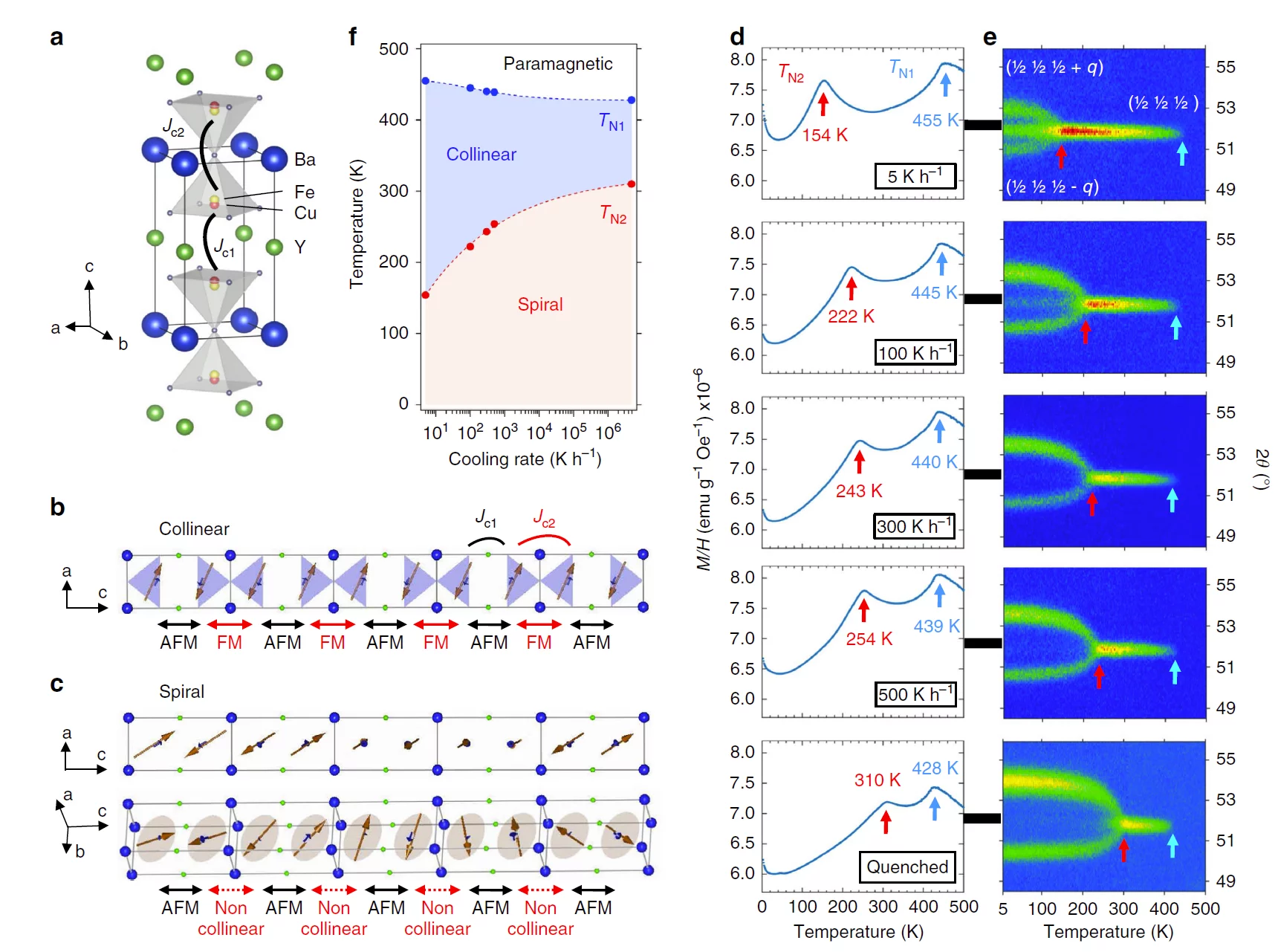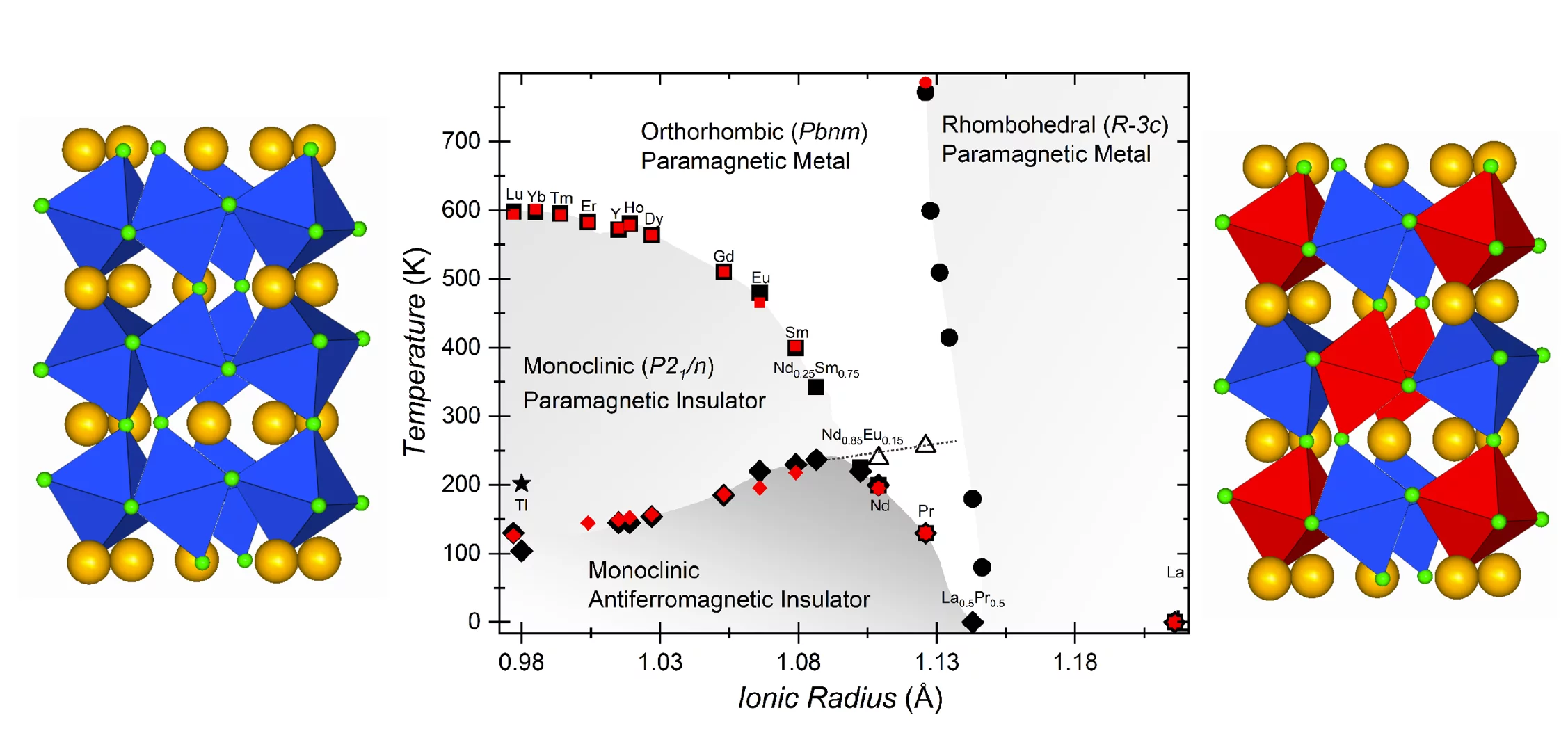Multiferroics
The term multiferroics is commonly used to designate materials where magnetism and electric polarization and simultaneously present and display a certain degree of coupling. Among them, there is a subset where the polarization is induced by a particular class of magnetic spirals. Such materials are extremely rare, but their unusual coupling between magnetism and ferroelectricity makes them potentially interesting for applications in spintronics and low-power electronics.
An important drawback is that magnetic spirals are rarely stable above 100 K, making their promising multifunctionalities useless for real-life applications. In our group we are presently investigating ways to mitigate this problem. Most of our investigations are centered in layered perovskite oxides, where we recently succeeded to increase the spiral order temperature up to 400K.
We collaborate on this topic with the Solid State Chemistry, Mesoscopic Systems, Spectroscopy of Novel Materials and Condensed Matter Theory groups (PSI), as well as with the Materials Theory (ETHZ). We also make extensive use of the PSI large scale facilities SINQ (neutrons), SLS (synchrotron x-ray) and LMU (muons).
Some recent related publications:
- YBa1-x SrxCuFeO5 layered perovskites: exploring the magnetic order beyond the paramagnetic - collinear - spiral triple point
V. Porée et al., arXiv 2402.04816 - REVIEW ARTICLE: Room temperature magnetoelectric magnetic spirals by design
A. Romaguera and M. Medarde, Frontiers in Materials 11, 1448765 (2024) - Cobalt-free layered perovskites RBaCuFeO5+δ (R = rare earth) as electrocatalysts: Impact of the R-cation in the Oxygen Evolution Reaction activity
E. Marelli et al., Energy and Environmental Science - Catalysis 2, 335-350 (2024) - Weak ferromagnetism linked to the high-temperature spiral phase of YBaCuFeO5
J. Lyu et al., Physical Review Research 5, 023008 (2022) - Design of magnetic spirals in layered perovskites: extending the stability range far beyond room temperature
T. Shang et al., Science Advances 4, eaau6386 (2018). - Tuning magnetic spirals beyond room temperature with chemical disorder
M. Morin et al., Nature Communications 7, 13758-13764 (2016) - Incommensurate magnetic structure, Fe/Cu chemical disorder and magnetic interactions in the high temperature multiferroic YBaCuFeO5
M. Morin et al., Phys. Rev. B 91, 064408-064421 (2015)
Links to press releases and popular summaries
- https://nccr-marvel.ch/highlights/2021-09-rare-earth-nickelate
- http://nccr-marvel.ch/highlights/2018-07-magnetic-spirals-for-spiralling-data
- https://www.manep.ch/tuning-magnetic-spirals-with-chemical-disorder-beyond-room-temperature/
- https://www.cambridge.org/core/journals/mrs-bulletin/news/adjusting-chemical-disorder-stabilizes-multiferroic-magnetic-spirals-at-higher-temperatures
- Towards energy saving data storage
Correlated oxides at the crossover from localized and itinerant behaviour
The evolution of the physical properties at the crossover from localized to itinerant behavior in highly correlated electron systems remains a fundamental problem of solid-state physics. Several perovskite families, among them rare earth nickelates, constitute particularly well suited systems to investigate this region. These materials feature spontaneous metal-to-insulator transitions (MIT’s) at temperatures controlled by the size of the rare-earth cation, allowing a continuous study of this region in a particularly clean way.
We are interested in the mechanism(s) at the origin of the MIT in rare earth nickelates. For that reason we are presently re-investigating the crystal structure and properties of these materials.
We collaborate on this topic with several experimental groups, as well as with theory groups at the NCCR MARVEL. We also make extensive use of the PSI large scale facilities SINQ (neutrons), SLS (synchrotron x-ray) and LMU (muons).
Some recent and past publications on RNiO3 perovskites:
- Magnetostructural coupling at the Néel point in YNiO3 single crystals
D. Gawryluk et al., Chemistry of Materials 36, 7811 (2024). - Elastic moduli from crystalline micro-mechanical oscillators carved by focused ion beam
Estry et al., Review of Scientific Instruments 95, 073905 (2024). - Raman spectroscopic evidence for multiferroelectricity in rare earth nickelate single crystals
I. Ardizzone et al., Physical Review Research 3, 033007 (2021). - RENiO3 single crystals (RE = Nd, Sm, Gd, Dy, Y, Ho, Er, Lu) grown from molten salts under 2000 bar oxygen-gas pressure
Y.M. Klein et al., Crystal Growth and Design 21, 4230 (2021). - Distortion mode anomalies in PrNiO3: Illustrating the potential of symmetry-adapted distortion mode analysis for the study of phase transitions
D. Gawryluk et al., Phys. Rev. B 100, 205137-205152 (2019). - 2Ni3+ → Ni3+d + Ni3-d charge disproportionation in RNiO3 perovskites (R = rare earth) from high-resolution x-ray absorption spectroscopy
M. Medarde, C. Dallera, M. Grioni, J. Mesot, M. Sikora,P. Glatzel, M.J. Martínez-Lope and J.A. Alonso, Phys. Rev. B 80, 245105-245110 (2009). - Long-range charge order in the low temperature insulating state of PrNiO3
M. Medarde, M.T. Fernández-Díaz and Ph. Lacorre,
Phys. Rev. B 78, 212101-212104 (2008). - Giant 16O - 18O isotope effect on the metal-insulator transition of RNiO3 perovskites (R = rare earth)
M. Medarde, P. Lacorre, K. Conder, F. Fauth and A. Furrer.
Phys. Rev. Lett. 80, 2397-2400 (1998). - Structural, magnetic and electronic properties of RNiO3 perovskites (R = rare earth).
M. L. Medarde, Review article.
J. Phys. Condens. Matter 9, 1679-1708 (1997). - High pressure neutron-diffraction study of the metallization process in PrNiO3.
M. Medarde, J. Mesot, S. Rosenkranz, P. Fischer, P. Lacorre and K. Gobrecht.
Phys. Rev. B 52, 9248-9258 (1995). - RNiO3 Perovskites (R = Pr, Nd): Nickel valence and the metal-insulator transition investigated by x-ray absorption spectroscopy.
M. Medarde, A. Fontaine, J.L. García-Muñoz, J. Rodríguez-Carvajal, M. de Santis, M. Sacchi, G. Rossi and P. Lacorre,
Phys. Rev. B 46, 14975-14984 (1992).


